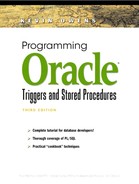9.9. USER_ERRORS
SHOW ERRORS is a SQL*Plus command. It returns information from the USER_ERRORS view, which has the following description:
SQL> desc user_errors Name Null? Type ------------------------------ -------- ---------------- NAME NOT NULL VARCHAR2(30) TYPE VARCHAR2(12) SEQUENCE NOT NULL NUMBER LINE NOT NULL NUMBER POSITION NOT NULL NUMBER TEXT NOT NULL VARCHAR2(4000)
You can select compiler error results when not running SQL*Plus by querying this view. The USER_ERRORS view contains errors for objects compiled in your schema. ALL_ERRORS and DBA_ERRORS are other views with wider scope. Refer to Chapter 5 for a complete description of the differences between the USER, ALL, and DBA data dictionary views. The following is a description of the columns.
| NAME | This is the name in the CREATE OR REPLACE clause. This is not the host file. Running the script @MY_HELLO.SQL with a CREATE OR REPLACE PROCEDURE HELLO statement creates the object name HELLO. The data dictionary stores all attributes in upper case. |
| TYPE | This is FUNCTION, PROCEDURE, PACKAGE, or PACKAGE BODY. There is never an underscore in PACKAGE BODY. |
| SEQUENCE | This corresponds to the error number relative to the number of errors in the compile. |
| LINE | This is the list-file line number, which contains the error. This corresponds to the LINE column in USER_SOURCE. |
| POSITION | This is the column position of the error. |
| TEXT | This contains the text of the error. For example: PLS-00302: component 'PUTLINE' must be declared |
..................Content has been hidden....................
You can't read the all page of ebook, please click here login for view all page.
